Continuing a Living Legacy: A Dual Interview with Dr. Ebony Joy Wilkins and Dare Coulter About Zora the Story Keeper
When it comes to writing picture books, reality may be the hardest topic to portray. Every day at my lunchtime I make a point to read at least five new picture books. By doing this, I get a clear sense of what’s being published in this current day and age. And while I cannot tell you that reality is uncommon in picture book publishing, I can say that it’s far less common than more fantastical picture book plots. Now when I first laid eyes on the book Zora the Story Keeper I noted a couple features right off the bad. First off, here we had Dare Coulter, fresh off of her other picture book triumph this year. An American Story with Kwame Alexander. And here we also had Dr. Ebony Joy Wilkins, best known to me personally for her biography on Katherine Johnson (winner of a Mathical Honor, thank you very much). Together, what could they do? They could create this story:
When Zora grows up, she wants to be just like Aunt Bea. Aunt Bea is the best storyteller she knows! Every day after school, Zora heads to her aunt’s house, where they take out their family book and turn Aunt Bea’s kitchen into their stage. They raid Aunt Bea’s costume chest, filled with colorful garments from her acting days, and even do special voices to tell the stories of swimming coaches, Sunday preachers, World War II pilots, and more—all real members of their family. Zora can’t wait to find out what her story will be. As the days pass, Zora notices something’s happening to Aunt Bea. She gets tired more quickly, and sometimes she needs Zora to tell the stories instead. Zora never imagined that Aunt Bea’s tales would ever stop, but in addition to creating lots of joy and a lifetime of memories, Aunt Bea had been working on her greatest gift of all: preparing Zora to become the story keeper.
Today I’ve the very great honor of talking to both Ebony and Dare about this title. A title that, and I mean this sincerely, is one of my favorite picture books of 2023.
ADVERTISEMENT
ADVERTISEMENT
Betsy Bird: Thank you so much for answering my questions here today, Ebony. I think it’s impossible to read ZORA, THE STORY KEEPER, and not wonder about where it came from. The characters in this book have a presence to them that makes them feel far more real to the reader than what you find in a lot of other picture books. So just to start us off, where did this story come from?
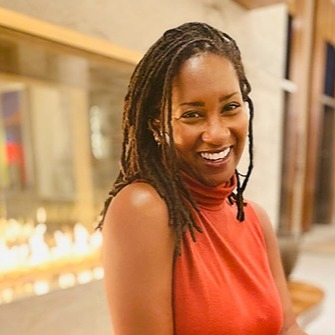
Ebony Joy Wilkins: My favorite childhood memories involve storytelling. Visits to the library. Book fairs at school. Youth group at church. Laughter around the dinner table. My family gathers like most, for holidays, weddings, funerals, reunions, and graduations. Together we tour new cities, play games, eat well from my grandma’s recipes, we laugh, and sometimes, we cry. My favorite thing about stories is that they live on forever. And as we lose or move on from someone, the stories remain with us. In our family, the tales have been passed from generation to generation. In my writing, I pull from all of the stories that I have heard over the years and try to piece together a story that will resonate in a meaningful way. Reading the words of Black writers and seeing myself reflected in their work influenced my writing as well. When I complained about not having enough of these stories as a child, my mom issued me a challenge, asking, “What are you going to do about it.” That challenge would stick with me. ZORA, THE STORY KEEPER is the result of a lifetime of shared stories, storytelling traditions, and a thoughtful challenge.
BB: I love that. And Dare! Thanks so much for answering my questions too . Also, congrats on having just an incredible debut picture book year! Can you tell us a little bit about how you came to this project? Why did you decide to take it on?
Dare Coulter: Howdy!! Okay before I get into answering questions I need to tell you that this is a fan moment for me; I saw your article about An American Story when it came out, and I don’t even know how many times I’ve read it at this point. Seeing you take An American Story on the news was so heart warming for me. Also, it felt mind-blowing to see my debut book be your Caldecott prediction earlier in the year! I saw that it got dethroned a few months into its run, but just know that seeing it be your forerunner was a really special moment for me. I went to the ALAs for the first time this year and only saw after that you were there—I was so sad to have missed you, but I’ll see you one of these days! Thank you so much!

Zora the Story Keeper was actually the first manuscript that came in to my agent; An American Story (AAS) came in right after, and then we were faced with having to figure out which direction to go in first. We were at the beginning of the popup of the discussion around Critical Race Theory as it was becoming a weird umbrella term to refer to books and curriculums that talk about racism and/or black culture in any capacity. The time for that book to be made was definitely right then—and it’s good, because AAS is now a space to talk about slavery in a way that doesn’t turn it into this camaraderie-fest that certain modern people swear it was. It says this atrocity occurred and these were the human impacts of that. Sculpture was used in this instance to underscore the humanness of the people whose story it is telling. We crossed our fingers and hoped that the team behind Zora would wait for us—and we were so grateful that they did because I thought the manuscript was stunning.
When I was parsing through thumbnails and figuring out a visual language for the book I was so aware of the emotional intensity of the book because I could not stop crying—I’ll elaborate on that more in a bit! That intensity is the same thing I felt when I was reading the manuscript for the first time. The same thing that made me want to take on this manuscript was the same thing that made pride well up in my chest when we sat at my cousin Elfrida’s house and looked at pictures of my ancestors. My grandfather’s grandfather was one of the first mayors of Eatonville, there’s a woman who owned a general store and another who owned a taxi company. My father’s father was a cowboy and bull rider, and he won silver belt buckles back when they wouldn’t give prize money to black people. Dr. Ebony made an AMAZING book that is incredibly relatable because it makes you feel like these stories belong to you and your ancestors. She perfectly captured the pride and excitement that we have when we say that these are the people who we came from.
BB: Thank you, Dare (and believe me, I think AAS is going to win something this award season, one way or another!). Dr. Wilkin, why don’t you tell us a little bit about the role of the storykeeper. I know that in a lot of families, there’s always that one member who remembers the family lore and stories and keeps these stories going for everyone else. Do you have someone like that in your own family?
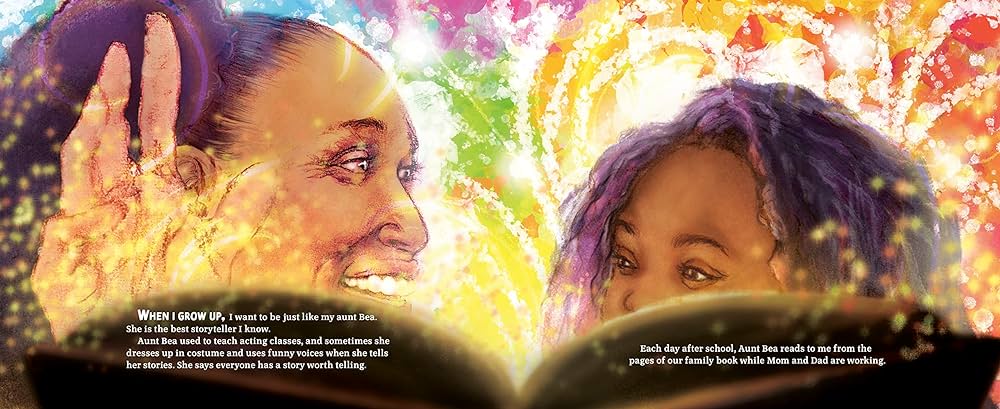
EJW: We do! When I was young, I remember my mom, along with her sorority members, put on a Black History Month play about influential Black women to know. She dressed as Phillis Wheatley Peters, the first African American woman to publish a book of poetry, and spoke confidently on stage in front of my entire class. I remember feeling proud and inspired. Since then, my parents have shared more lessons, like the importance of our history, the power of prayer, caring for family, and the value of education. A few years after that play, my mom began ancestral research to collect family stories to pass on to us. We now each have a family book outlining our ancestry, and to this day, they continue to share stories with us and in their
community. I’m proud that I can continue their living legacy by sharing stories like ZORA, THE
STORY KEEPER.
BB: Beautiful. And Dare, let’s talk about the medium in which you created this art. I think a lot of folks are familiar with your work on An American Story with Kwame Alexander. This book doesn’t utilize model work the way that one did but you are using charcoal on paper, acrylics, Procreate and some Photoshop.
DC: Yes!! AAS was a headlong jump into something different, but that isn’t stylistically appropriate for every book, of course. Enslaved people were definitely human beings, but their humanity was stripped from them by the people who were using them as equipment. Once you can strip humanity away from a person you’re free to do whatever you want to the human without it reflecting as your own lack of humanity; no one wakes up and cares if their dishwasher is feeling sad today. Sculpture was appropriate because it moves through 2D space into being an actual physical thing. It’s the closest I could get to photographic
people without it being a book made with photos.
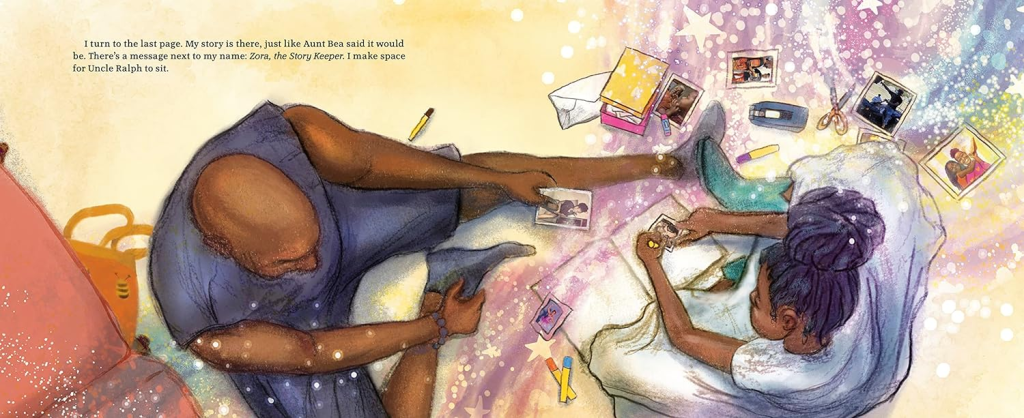
For Zora, there wasn’t the same need, but it also didn’t feel like sculpture made the most sense as a story told with this young character. Having a lighter style let me do things that could bend to be magical in instances and reflective in others, in ways that paint wouldn’t have been the best for, either. I think there are many artists caught in a no man’s land with the prominence of digital art tools but the track-record of analog media that they know and love, and they want to have it still make sense in the space of their digital works. That’s where I find myself tagging back and forth between media, especially those that have been so close to my heart for so long. I’ve got one more trick up my sleeve with mixed media, we should see it in a future book! I do think I’ll have the mixed-media thing happen for a long time. I love being able to have different mediums work together to create something that feels alive in a different way; it feels like speaking different languages.
BB: And Dr. Wilkins, part of what I like so much about this book is the way in which the book is so honest about portraying the ways in which even the most loving of adults can put kids into difficult situations. In reading this story there’s a level where kids will understand what’s happening and another level where adults understand a bit more. How did you decide how much to show and how much to tell when writing this story?
EJW: I have taught and learned alongside students of all ages and the common sentiment is that we all desire truths. I keep that thought close to my mind as I am teaching, researching, and writing stories. I remember having parents ask me the best way to share sad news with their children. I always recommend books. When my students ask questions about sad news, we take a trip to the library. When we don’t have the right words, books can open the door to conversations about the most difficult situations. There was a time in my life when library visits were a weekly occurrence. I remember searching for stories that revealed truths and those that illustrated accurate portrayals of our existence and experiences. This search and those stories helped to shape who I am today. Many of my students report the same. Loss, love, stories, and family are our shared experiences. So, I decided to write ZORA, THE STORY KEEPER in a way that would help reveal truths and also support difficult conversations.
BB: Thank you! Dare, another illustration question for you. On the publication page it says that in this book, “The photographs are pictures from both Dare Coulter’s and Dr. Ebony Joy Wilkins’s lives.” Amongst those photos is a woman who your Aunt Bea looks to have been modeled on. Can you tell us a little bit about who that is? And did you work with Dr. Wilkins at all to get the look of the characters right or did you work entirely on your own?
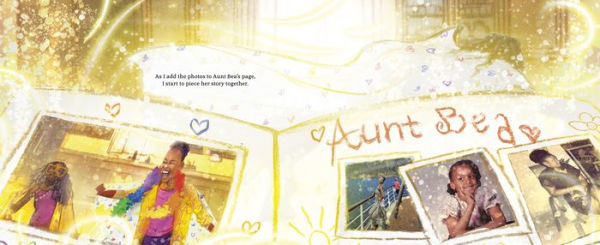
DC: That’s my momma, y’all!!! Aunt Bea is modeled on my mom for a number of reasons, all which have to do with her being similar to this character, and not at all with having to do with her availability and proximity. When I read through the manuscript it felt a lot like how my mom moves in the world, mixed with my older sister who is the person who remembers in our nuclear family. She keeps in touch with everyone in a way that I wish I had the bandwidth and capacity for. I just know that I’m bad at responding to texts and social media because I can either do my work or I can do that—I haven’t been able to successfully do both. I’m afraid of my mom dying more than I’m afraid of most things in this world. I’m fortunate to have a beautiful relationship with her, one that evolved into a unique friendship in my adulthood. Just the sheer concept of being untethered from her is something I’m barely able to process even though I know it’s coming one day. So this book having her as the model ended up with me having my heart in my stomach for so much of this process; I kept crying those tears that burn your throat. It was hard!
The characters in the book are my design! I had a model, and she was an EXCELLENT model, but the reference is just a starting point. In my experience—and based on the experience of other illustrators I’ve talked with—the illustrator and author of a book don’t end up interacting until a certain point toward the end. And it’s for the better! If you trust an illustrator enough to hire them onto the project, you have to trust that they, with the guidance of the art director and editor, will be making the creative decisions that will bring the manuscript to life. But at the point that Dr. Ebony became involved she was so excited about the work that had been created!
BB: Awww! Your mom! And Dr. Wilkins, this is a book that gives full credit to kids’ abilities to understand what, at its heart, is a pretty serious story. There’s a reality to it that I wish I saw more of in children’s picture books these days. How much did the final manuscript differ from your original version of it? What were some of the changes you decided to make?
EJW: Thank you for saying so. I’ve been teaching for a long time so I know how capable even the youngest learners are. I believe that children understand more than we often give them credit for so I did not hold back in ZORA, THE STORY KEEPER. There is an element of truth that you can find in all of the stories that I write because I hope that adding a bit of myself into the story makes for a more authentic experience for the reader. The final manuscript is similar to the original. Once Dare had the brilliant idea to add our family photos, I edited a few of Zora’s
favorite activities that she believes will be included on her page, like playing jump rope.
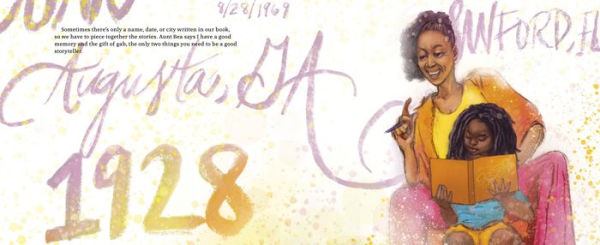
BB: Well, speaking of those photos, Dare, when you’re putting together a book like this, what influences your choices on where to put one medium or another? For example, sometimes a photo is drawn and sometimes it’s an actual photograph. Do you plan out how each spread will go ahead of time down to the last detail, or is there a bit of flexibility and spontaneity to each piece of art?
DC: Honestly there’s something fascinating that comes from the spontaneity! The photos popped in when I was using them as placeholders for pictures that I would ultimately draw; and when I opened the file back up to work on it again I got excited about the possibility that there could be photos in the spread. I loved how they looked—they felt like ephemera in the space of a painting. There are artists who are able to post side-by-side pictures of the mockup versus their final installed piece, and they look exactly the same. I’m not that person! I cherish the vibrance that comes from having the space to be flexible, and I work from very loose sketches so that I can save room for the art to push itself further than the lines that I drew out
for it to exist in.
BB: And Dr. Wilkins, how do you feel about Dare Coulter’s art for the book?

EJW: My book projects are so personal. I call them my book babies. It can be an overwhelming
thought to hand over something so personal for someone else’s care and interpretation. However, once I was introduced to Dare’s work and art for this project, ZORA, THE STORY KEEPER came alive. I have joked before that Dare and I co-parent well to our book baby. It’s a match made in heaven to me. Dare’s work is vivid, inspiring, and so real…everything I aspire to be as a writer. This would be an entirely different book without her contributions and vision.
BB: And Dare, was there anything in particular that you had to change or rework in the course of this process? Anything that had to be left on the cutting room floor?
ADVERTISEMENT
ADVERTISEMENT
DC: Honestly, mostly no! The cutting room floor stuff happened before the manuscript started! Rubin Pfeffer is my agent and I love him to pieces, and we worked through the visual language of this book together until it felt like it reached the output that made the most sense. The cutting room floor has tons of pieces of all of the pre-work on it, but once we found the language? Oh that was it, it was full steam ahead!
BB: Finally, and this is a question for the both of you, what do you have coming out next for us?
EJW: I will forever be trying to answer that challenge from my mom. I have a couple of stories in progress, including a chapter book about a friend group at camp for the summer and a picture book about a friend group on an overnight adventure through the stacks of a library. I also have a book club subscription called Ebony Kids by my company, Curriculum Cafe, so I will be choosing and mailing the next round of children’s books soon.
DC: An ode to black girl magic by Jessica Care Moore called Her Crown Shines is coming out next! It’s about Supreme Court Justice Ketanji Brown Jackson and it’s super sweet. Wildly there is another book with Kwame Alexander coming, too! He posted a Facebook live and told the world about it when we were in St. Helena doing research, so I think it’s safe to share it here 🙂 Excitingly, I’ve been doing some writing so there are some neat things on the way. In the space of my personal art I’m in some special places with sculptures, and I’m hoping that this year or next is when we see a figurative monumental sculpture from Dare Coulter. It’s all on the way!
Are not they awesome? Honestly, Zora the Story Keeper is such a pleasure to read. I highly urge you to seek it out for yourself. There’s really nothing else like it on the market today. In the meantime, I thank Dr. Ebony Joy Wilkins and Dare Coulter for so patiently answering my questions. Thanks too to Kaitlin Kneafsey and the folks at Penguin Young Readers for passing along my questions. Be sure to check this book out!
Filed under: Best Books, Best Books of 2023, Interviews
About Betsy Bird
Betsy Bird is currently the Collection Development Manager of the Evanston Public Library system and a former Materials Specialist for New York Public Library. She has served on Newbery, written for Horn Book, and has done other lovely little things that she'd love to tell you about but that she's sure you'd find more interesting to hear of in person. Her opinions are her own and do not reflect those of EPL, SLJ, or any of the other acronyms you might be able to name. Follow her on Twitter: @fuseeight.
ADVERTISEMENT
ADVERTISEMENT
SLJ Blog Network
2024 Books from Printz Winners
Exclusive: Vol. 2 of The Weirn Books Is Coming in October | News
Fighting Public School Book Bans with the Civil Rights Act
ADVERTISEMENT







